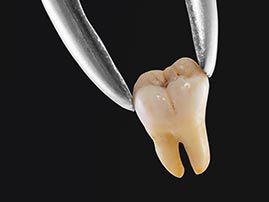Single Tooth Extraction
 Sometimes a tooth has to be removed from the socket in the bone. It might have decay, gum disease or a fracture beyond what we can repair. Or we may need to remove it for space or prior to placing orthodontic braces. And some teeth are poorly positioned and need to be removed. A common example of this is the ‘third molar’ or wisdom tooth.
Sometimes a tooth has to be removed from the socket in the bone. It might have decay, gum disease or a fracture beyond what we can repair. Or we may need to remove it for space or prior to placing orthodontic braces. And some teeth are poorly positioned and need to be removed. A common example of this is the ‘third molar’ or wisdom tooth.
Here are other reasons:
- Some people have extra teeth that block other teeth from coming in.
- Sometimes baby teeth don’t fall out in time to allow the permanent teeth to come in.
- People getting braces may need teeth extracted to create room for the teeth that are being moved into place.
- People receiving radiation or cancer drugs may develop infected teeth due to weakened immune systems.
- Wisdom teeth, also called third molars, are often extracted either before or after they come in. They commonly come in during the late teens or early 20s. They need to be removed if they are decayed, cause pain, have a cyst or infection or are headed in the direction of some misalignment issue. These teeth often get stuck in the jaw (impacted) and do not come in. This can irritate the gum, causing pain and swelling. In these cases, the tooth must be removed. If you need all four wisdom teeth removed, they are usually taken out at the same time.
How do I know if my tooth needs to be removed?
Your periodontist will make the recommendation for a tooth extraction based on your examination and radiographs (usually between the ages of 17-22). Not all wisdom teeth have to be removed; in some cases there is adequate room and the wisdom tooth can come in and function normally. In other cases, the wisdom tooth stays buried in bone and is unlikely to erupt. And in some cases, the wisdom tooth never forms at all. The most common wisdom tooth problem occurs when the tooth comes into the mouth only part of the way and then stalls. In these instances, it is best to remove these teeth at a recommended time and not wait until they have caused damage, or become infected at the worst possible time (while on vacation, etc.).
How do you do a tooth extraction?
You may hear people talk about getting a tooth “pulled”. This is an unfortunate term, we don’t pull out teeth to remove them. If we did, we could easily damage the surrounding teeth, gums and/or bone. If a tooth needs removal, we numb the area around it and then “luxate” it. To luxate a tooth, we move it from side to side until it loosens, then it is gently lifted out of the mouth. Sometimes we will cut the tooth into two or more pieces to remove it safely, especially if it has several roots going different directions.
What can I expect after I have my tooth removed?
Every case is different and after the tooth is removed your dentist will review with you what to expect. In general, a small amount of discomfort is normal immediately after the freezing comes out. At this point, some patients will take ibuprofen or acetaminophen. Bleeding or swelling are usually minimal, but again, your dentist can tell you what to expect with your particular case.
Do I need to replace my tooth once it is removed?
Again, this depends on the individual case. Some teeth are important for function or aesthetics; for example, the first molar tooth is very important for chewing and taking the bite force to protect the other teeth from damage/loss. Some other teeth, such as wisdom teeth, are rarely replaced. Ask your South Calgary Periodontist what the right treatment option is for you!
At South Calgary Periodontal Group, we are always welcoming new patients.
Call us at (403) 278-5446 to book your Tooth Extraction consultation appointment today!
